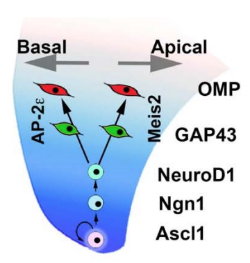Abstract
The vomeronasal organ (VNO) contains two main types of vomeronasal sensory neurons (VSNs) that express distinct vomeronasal receptor (VR) genes and localize to specific regions of the neuroepithelium. Morphogenic signals are crucial in defining neuronal identity and network formation; however, if and what signals control maturation and homeostasis of VSNs is largely unexplored. Here, we found transforming growth factor β (TGFβ) and bone morphogenetic protein (BMP) signal transduction in postnatal mice, with BMP signaling being restricted to basal VSNs and at the marginal zones of the VNO: the site of neurogenesis. Using different Smad4 conditional knockout mouse models, we disrupted canonical TGFβ/BMP signaling in either maturing basal VSNs (bVSNs) or all mature VSNs. Smad4 loss of function in immature bVSNs compromises dendritic knob formation, pheromone induced activation, correct glomeruli formation in the accessory olfactory bulb (AOB) and survival. However, Smad4 loss of function in all mature VSNs only compromises correct glomeruli formation in the posterior AOB. Our results indicate that Smad4-mediated signaling drives the functional maturation and connectivity of basal VSNs.
